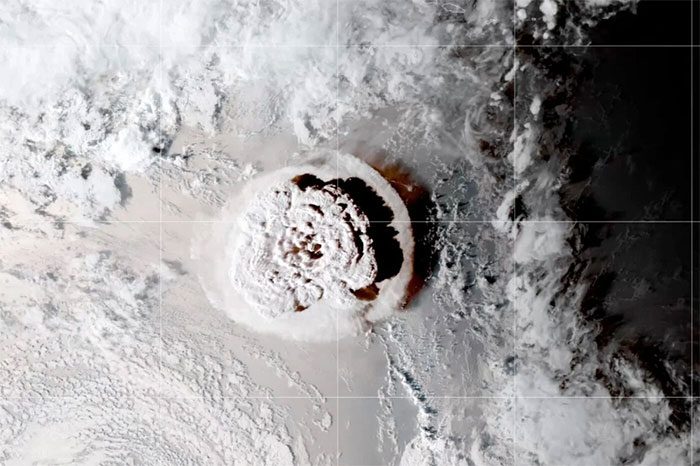Before the Tonga volcano erupted violently, shaking the Pacific Ocean, no surface activity was reported, but seismometers detected unusual signs.
In 2022, the Hunga Tonga-Hunga Ha’apai volcano in Tonga erupted, destroying the island of the same name, burying everything in ash and causing numerous fatalities. The eruption not only triggered tsunamis that struck the coastlines of Tonga but also spread across many Pacific nations, reaching as far as the United States and Japan, while leaving Tonga cut off from the outside world for several days.
Predicting such natural disasters is extremely challenging, but a recent discovery suggests that some volcanoes may emit signs before a violent eruption.

Satellite image of the Tonga volcanic eruption – (Photo: NASA).
After reviewing some overlooked data from the Tonga volcano event, a group of researchers stated that the massive eruption that shook the Pacific was preceded by a wave of seismic activity moving across the Earth’s surface.
According to the science and technology news site Gizmodo, the research team examined data from seismometers in Fiji and Futuna, located over 750 km from the eruption site. In that data, they found a type of surface wave known as Rayleigh waves, which emanated from the direction of the catastrophic eruption about 15 minutes prior to the event.
Humans cannot feel Rayleigh waves, but seismometers easily recorded them.
“Based on other seismic signals and satellite imagery, we conclude that Rayleigh waves are the most important precursors to the eruption without any apparent surface activity“, the researchers wrote in their paper, published in the journal Geophysical Research Letters.
The record-breaking eruption of the Hunga Tonga-Hunga Ha’apai volcano occurred on January 15, 2022. The plume of gas reached 58 km high, the largest ever recorded, and extended to the mesosphere of the Earth in just half an hour.
As the research team noted, prior to this eruption, there were no “apparent surface activities.” Therefore, Rayleigh waves served as the primary indicator of the impending catastrophic event.
“During regular earthquakes, seismic waves, including Rayleigh waves, are used immediately to estimate parameters such as the epicenter, depth, and magnitude,” said Mie Ichihara, a volcanologist at the University of Tokyo and co-author of the study.
“These parameters are then used to issue early tsunami warnings. However, currently, there is no infrastructure to utilize Rayleigh waves as precursors to volcanic eruptions as identified in our paper, although we believe this would be useful.”
The research team suggests that analyzing data from seismometer stations located hundreds of kilometers away from an eruption could help detect events before they cause the worst impacts.
“At the time of the volcanic eruption, we did not consider using this type of analysis in real-time. But next time there is a significant underwater eruption, local observatories may be able to recognize it from their data,” she added.
Early Warning Systems for Volcanoes and Tsunamis Early warning systems for natural disasters such as earthquakes, volcanoes, and tsunamis, as well as predictable events like hurricanes, tornadoes, and severe storms, can save many lives. Any lead time is better than none, as even just a few minutes of warning can make the difference between life and death. Researchers are continually finding new methods to detect potential disasters early. In 2021, a group of earth scientists discovered that it is possible to predict tsunamis based on their magnetic fields, which will arrive before sea levels change—the familiar sign warning of the emergence of massive “walls of water.” The Hunga Tonga-Hunga Ha’apai eruption could have been much more devastating had it occurred in a more populated area. Researchers hope that insights gained from this record-breaking eruption can help humanity better prepare for similar events in the future. |


















































